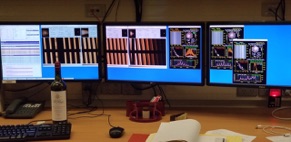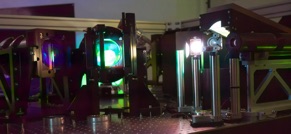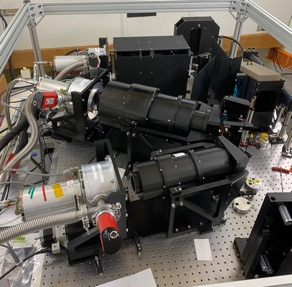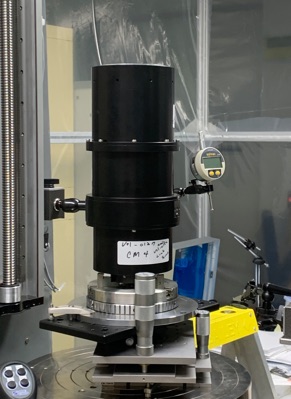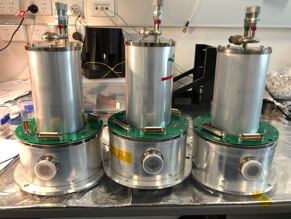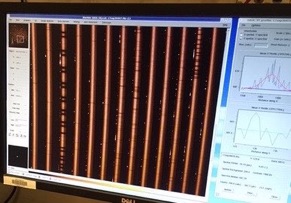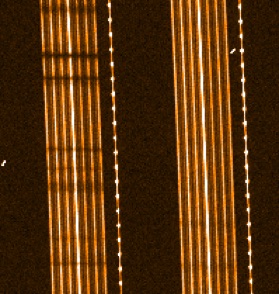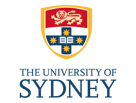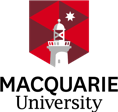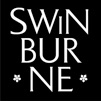The Veloce project equips the Anglo-Australian Telescope with a compact, stabilised and hyper-calibrated spectrograph, able to obtain Doppler velocities for Sun-like and M-dwarf stars at sub-m/s precision. When complete it will provide essentially all the functionality delivered of the old UCLES spectrograph - but with a larger collecting aperture on the sky, higher spectral resolution, simultaneous wavelength coverage across the whole optical, and better throughput.
Key features of Veloce
-
 A CYCLOPS-style IFU fibre-feed
A CYCLOPS-style IFU fibre-feed -
 Compact asymmetric, white-pupil design, including pressure and temperature stabilisation.
Compact asymmetric, white-pupil design, including pressure and temperature stabilisation. -
 Wavelength coverage of ~390-930nm at R~80,000 in three cameras : Azzurro 391-431nm, Verde 431-590nm, and Rosso 590-930nm
Wavelength coverage of ~390-930nm at R~80,000 in three cameras : Azzurro 391-431nm, Verde 431-590nm, and Rosso 590-930nm -
 Simultaneous calibration by a pulsed-laser-comb to deliver a bright, calibration source stable at the few cm/s level, with tens-of-thousands of lines across the green and red cameras.
Simultaneous calibration by a pulsed-laser-comb to deliver a bright, calibration source stable at the few cm/s level, with tens-of-thousands of lines across the green and red cameras.

Veloce Rosso has been available since 2019, and the Verde and Azzurro cameras are being commissioned in June-August 2023. Any Australian astronomer can apply for use it as a standard facility instrument on the AAT.
International astronomers can purchase time on the AAT to use Veloce - enquiries regarding the terms and conditions for AAT Paid Time should be made through Astronomy Australia Limited (AAL).
You don't have to collaborate with the Veloce team to get time - but we are happy to work with you if you'd like to work with us. In particular, many Veloce science programs benefit from sharing time across multiple programs, because while you might only need 2 nights for your favourite planet target, you want those nights spread over a much longer period.
We are happy to collaborate with teams who'd like to exchange time across the semester - please get in touch if you'd like to share time (modulo the requirement we then all have to share weather losses as well).

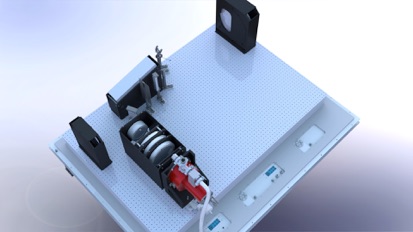
Veloce operated with a single red arm (Veloce Rosso) over the last 3 years (as in the design rendering above). Two additional arms (green and blue cameras - Veloce Verde and Azzurro - below) now being installed (as per the design below). The total budget for the project is now around $5.9m, raised by a consortium led by UNSW and including ANU, USQ, AAO, U.Sydney and Macquarie and Swinburne.
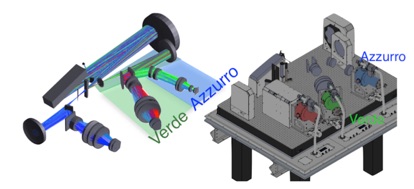
Our calibration system - VeloceCal - uses a pulsed-laser-comb calibration system covering 450-950nm from Menlo Systems GmbH. We inject this into Veloce as a single-mode, diffraction-limited calibration source, calibrating the spectrograph for every science exposure. (The image below is the optical spectral flattening unit with its covers removed and "lit up" by the laser comb output spectrum)

The completed Veloce Rosso system was delivered to the AAT in April 2018.

Once sealed-up in its enclosure (above), its internal components (below) are temperature stablised at 25.00C to ~10mK and pressure stablised at 905.0mbar to better than 0.1mbar.
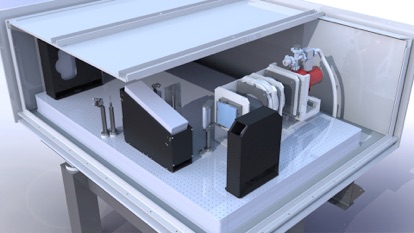

Veloce's fibre-fed design makes it amenable to a range of possible upgrades
-
1.A "faint object" fibre feed (i.e. larger fibres delivering spectra at lower-resolution, with more sky-fibre collection, and less read-noise through binning of the detector).
-
2.A science-quality slit-viewing camera.
-
3.VelocePol - a spectro-polarimetry module with dedicated fibre bundle at the AAT's Cassegrain focus.
-
4.Veloce-RAPTOR : a fibre feed from a 0.7m auxiliary telescope sited next to the AAT - allowing use of Veloce on every night of the year, and potentially upgradable with many more telescopes.

